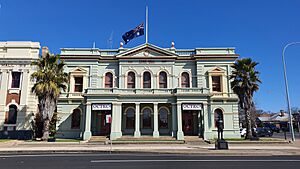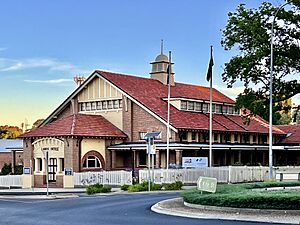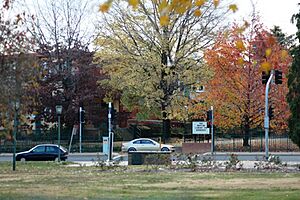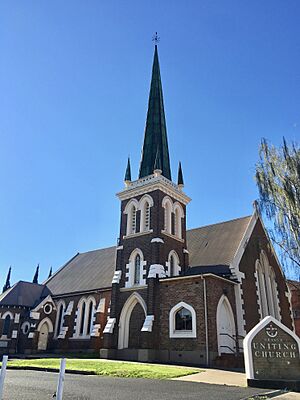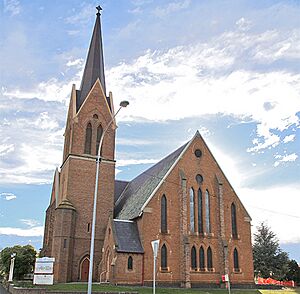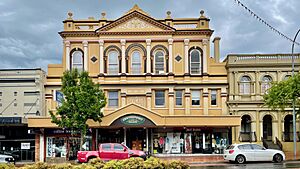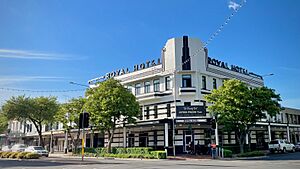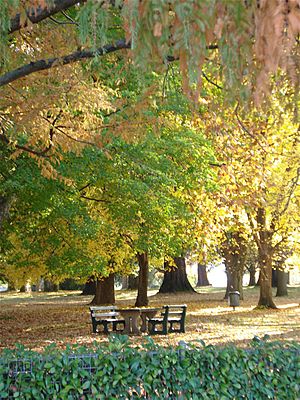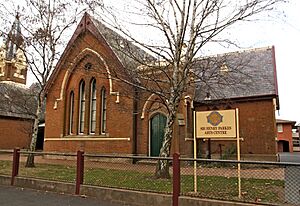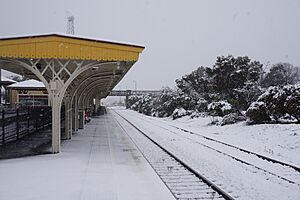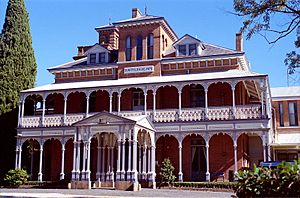Orange, New South Wales facts for kids
Quick facts for kids OrangeNew South Wales |
|||||||||||||||
|---|---|---|---|---|---|---|---|---|---|---|---|---|---|---|---|

Byng Street
|
|||||||||||||||
| Population | 41,920 (2021) (38th) | ||||||||||||||
| Established | 1846 | ||||||||||||||
| Postcode(s) | 2800 | ||||||||||||||
| Elevation | 863.2 m (2,832 ft) | ||||||||||||||
| Location | |||||||||||||||
| LGA(s) | City of Orange | ||||||||||||||
| Region | Central West | ||||||||||||||
| County | Wellington, Bathurst | ||||||||||||||
| State electorate(s) | Orange | ||||||||||||||
| Federal Division(s) | Calare | ||||||||||||||
|
|||||||||||||||
|
|||||||||||||||
Orange is a city in the Central Tablelands region of New South Wales, Australia. It is about 254 kilometers (158 miles) west of Sydney, the state capital. The city is located high up, at 862 meters (2,828 feet) above sea level.
In 2021, Orange had about 41,920 people living there. This makes it an important city in the region. A big landmark nearby is Mount Canobolas, which is 1,395 meters (4,577 feet) tall. You can see amazing views of the area from its peak. Orange is on the traditional lands of the Wiradjuri people.
Orange is famous for being the birthplace of two well-known Australian poets: Banjo Paterson and Kenneth Slessor. The very first Australian Touring Car Championship, now called the Supercars Championship, was held here in 1960.
Contents
- History of Orange
- Geography and Climate
- Economy and Jobs
- Education in Orange
- Churches in Orange
- Suburbs and Localities
- Population of Orange
- Mining in Orange
- Winemaking in Orange
- Media and News
- Fun Attractions in Orange
- Getting Around Orange
- Famous People from Orange
- Heritage Sites
- Water Resources
- Sister Cities
History of Orange
The land around Orange has been home to the Wiradjuri people for a very long time, possibly over 60,000 years. They are known as the people of the three rivers.
In 1822, Captain Percy Simpson came to the area. He set up a convict settlement called "Blackman's Swamp." This name came from James Blackman, a guide who had explored the region before.
Later, in 1829, a surveyor named J. B. Richards drew a map. On this map, he marked a village area in a place he called Orange. Sir Thomas Mitchell named the area "Orange" to honor the Prince of Orange. Mitchell had fought alongside the Prince during a war, and they were both helpers to the Duke of Wellington. The valley to the west was named after the Duke.
People started settling here in late 1829. Small settlements grew into towns as roads connected them. In 1846, Blackman's Swamp was officially chosen as the village site and named Orange.
A big discovery of gold happened nearby in Ophir in 1851. This started the Australian gold rush. More gold was found in other nearby areas, making Orange an important trading center for the gold miners.
Orange continued to grow because the land was great for farming. In 1860, it became a municipality, which is like a self-governing town. The railway from Sydney reached Orange in 1877. In 1946, 100 years after it was first established as a village, Orange became a minor city.
Before Canberra was chosen, Orange was even considered as a possible location for Australia's national capital city!
Geography and Climate
Because Orange is high up, it has a mild climate. Summers are warm, but mornings are cool. Winters are cold and wet, with many frosty mornings. Snow often falls in the cooler months. Orange gets more snow than most major cities in Australia. However, in recent years, there has been less snow due to climate change.
Orange has colder winters than most places in Australia, especially during the day. In summer, the highest temperatures are also lower than in many inland areas because of its high elevation. The air is not very humid in summer.
The climate here is perfect for growing apples and pears. It's also a great place for making wine that needs cooler weather.
Economy and Jobs
Orange is well-known for its fruit farms. They grow apples, pears, and many stone fruits like cherries, peaches, apricots, and plums. Interestingly, oranges are not grown here because the climate is too cool for them! In recent years, many vineyards have been planted for the growing wine industry. This wine industry, along with Orange becoming a famous place for gourmet food, has made it a popular spot for tourists.
Other big industries and employers in Orange include:
- The Cadia gold mine: This is a very large gold and copper mine about 20 kilometers (12 miles) south of Orange. It's one of the biggest open-cut mines in Australia. It employs many people and is expected to operate for many more decades.
- The New South Wales Department of Industry: This government department has its main office in Orange.
Education in Orange
Orange has many schools for students of all ages.
Primary Schools
- St Mary's Catholic Primary School
- Orange Public School (opened in 1880)
- Orange East Public School
- Calare Public School
- Orange Christian School
- Kinross Wolaroi School
- Bletchington Primary School
- Anson Street Public School
- Glenroi Heights Public School
- Bowen Public School
- Canobolas Public School
- Clergate Public School
- Catherine McAuley Catholic
- Orange Anglican Grammar School
Some primary schools are just outside the city but still serve the Orange area:
- Spring Hill Public School
- Nashdale Primary School
- Spring Terrace Public School
- Borenore Public School
- Mullion Creek Public School
Secondary Schools
- Orange High School
- James Sheahan Catholic High School
- Canobolas Rural Technology High School
- Orange Christian School (for all grades, K–12)
- Kinross Wolaroi School (for all grades, K–12)
- Orange Anglican Grammar School (for all grades, K–12)
- MET School Orange Campus (for grades 3–12)

University and College
- A campus of Charles Sturt University is located on the edge of northern Orange.
- A large campus of TAFE (a vocational education and training provider) is also in Orange.
Churches in Orange
Orange has many different churches:
- St Joseph's and St Mary's Catholic Churches
- Holy Trinity Anglican Church
- St Barnabas Anglican Church
- Orange Uniting Churches
- Orange Baptist Church
- Orange Presbyterian Church
- St Peter's Lutheran Church
- New Life City Church
- Orange Evangelical Church
- Orange Christian Assembly
- Mountain Hope Church
- Salvation Army
- Orange Seventh-day Adventist Church
- Orange Church of Christ
- Slavic Pentecostal Church
- The Church of Jesus Christ of Latter-Day Saints
- Open Heavens Church
Suburbs and Localities
Orange is made up of several suburbs and areas. Here are some of them:
- Ammerdown: A residential area to the northwest, along the Mitchell Highway.
- Bletchington: Mostly homes with one school. It's a large residential area, sometimes called North Orange. It includes the Orange Botanic Gardens and the Orange Adventure Playground.
- Bloomfield: Has farms, a golf course, the Orange Health Service (a big hospital), and a nature reserve.
- Borenore: About 15 kilometers (9 miles) west of Orange, mostly farmland. It's also where the Australian National Field Days are held.
- Bowen: Contains homes (including public housing), industrial areas, businesses, and government offices. It has the main road leading to Sydney.
- Calare: West of the city center, mostly homes. It has Calare Public School and Orange High School.
- Canobolas: Mainly a farming and recreation area, home to Mount Canobolas.
- Clifton Grove: Has farms and large residential blocks.
- Clover Hill: A residential suburb north of the city center.
- Glenroi: Mostly homes, including public housing. It also has industrial areas.
- Huntley: A locality south of Orange.
- Lucknow: A small historic mining village about 9 kilometers (6 miles) east of Orange.
- March: A locality north of Orange.
- Millthorpe: A village southeast of Orange. The Orange suburb part is farmland northwest of the village.
- Narrambla: Mainly industrial and farming land.
- Nashdale: A community about 8 kilometers (5 miles) west of Orange, centered around its public school and hall.
- Orange: This is the city's central business district (CBD). The main street is Summer Street.
- Orange East: East of the railway line, mostly homes with some small businesses.
- Orange South: Directly south of the CBD. It includes Wade Park and the Orange Base Hospital.
- Shadforth: A locality east of Orange.
- Spring Hill: A village southeast of Orange.
- Spring Terrace: A locality and small village south of Orange, with a primary school.
- Springside: A rural area south of Orange.
- Suma Park: A residential area on the eastern edge of Orange. It has Suma Park Reservoir, which is Orange's main water supply.
- Summer Hill: A residential, industrial, and farmland area on the southeastern edge of Orange.
- Warrendine: Mostly homes. It has James Sheahan Catholic High School and industrial land.
Population of Orange
In 2021, the Orange urban area had 41,920 people.
- About 7.8% of the people were Aboriginal and Torres Strait Islander.
- Most people (83.7%) were born in Australia.
- The next most common birthplaces were England (1.6%), India (1.2%), New Zealand (1.0%), Philippines (0.7%), and Nepal (0.6%).
- Most people (87.1%) spoke only English at home. Other languages included Malayalam, Nepali, Mandarin, and Tagalog.
- When asked about religion, 32.6% said No Religion, 26.3% were Catholic, and 15.6% were Anglican.
- Many people in Orange work in hospitals (7.1%), gold mining (4.8%), social assistance services (4.4%), state government (3.7%), and primary education (2.6%).
Mining in Orange
The Cadia-Ridgeway Mine is a very large gold and copper mine. It is located about 20 kilometers (12 miles) south of Orange. This mine has been growing since the 1990s and employs thousands of people. It is expected to operate for many more decades. Cadia is the second-largest open-cut mine in Australia. There are also big mineral deposits found in the Ridgeway underground mine, which is next to Cadia.
Winemaking in Orange
The Orange wine region is known for its excellent grape growing and winemaking. This is because of the area's special geology, soil, climate, and temperature. These factors work together to create grapes and wines with unique flavors and colors. The cool temperatures during most of the growing season, along with dry autumns, are perfect for growing grapes.
Wineries to Visit
Many wineries are located in or around Orange:
- Amour Wines
- Angullong Wines
- Atallah Wines
- Bloodwood
- Boree Lane
- Borrodell on the Mount
- Brangayne of Orange
- Canobolas Smith
- Cargo Road Winery
- Cooks Lot
- Colmar Estate
- Cumulus Estate
- Dindima
- De Salis
- Faisan Estate
- Habitat Vineyard
- Heifer Station Vineyard
- Highland Heritage
- Hoosegg Wines
- Mayfield Vineyard
- Montoro Wines
- Mortimer's Wines
- Nashdale Lane
- Orange Mountain Wines
- Patina
- Philip Shaw
- Printhie / Swift
- Ross Hill
- Rowlee Wines
- Rikard Wines
- Sassy Wines
- Sea Saw Wines
- Slow Wine Co.
- Strawhouse Wines
- Stockman's Ridge
- Swinging Bridge
- Tallwood Wines
- Tamburlaine Wines
- Word of Mouth Wines
Some other wineries also use grapes from the Orange region in their wines, such as Brokenwood Wines, Logan, Gartelmann, Windowrie, Eloquesta Wines, and Lowe Wines. In 2007, the famous Penfolds winery even released a special Chardonnay made with Orange region grapes.
Media and News
Orange has several radio stations, including 105.1 Triple M Central West, 105.9 Hit Central West, and FM107.5 Orange Community Radio. The Australian Broadcasting Corporation (ABC) also broadcasts from Orange.
The city receives five main TV channels: Seven, WIN TV (which shows Nine Network programs), Network 10, ABC TV, and SBS TV.
- Seven News creates a local news show for the Central West region. It airs every weekday at 6 pm.
- WIN Television also produces a local news show for the Central West. It airs every weekday at 5:30 pm.
- Network 10 provides short news updates throughout the day.
You can also get subscription TV services like Foxtel in Orange.
Local newspapers include the Central Western Daily, The Orange App (an online daily news service), the Midstate Observer, and Orange City Life.
Fun Attractions in Orange
Orange has many fun places to visit!
- You can go bushwalking on trails like Spring Glade Walking Track and Cook Park Heritage Walk.
- The Nangar National Park and Mullion Range State Conservation Area are great for exploring nature.
- Borenore Caves are a series of cool limestone caves.
- You can visit Duntryleague Golf Club, Mount Canobolas, and Federal Falls in the Mount Canobolas State Conservation Area.
- Lake Canobolas is a popular spot.
- The historic center of Orange and the Orange Botanic Gardens are also worth seeing.
- Elephant Park got its name because circuses used to visit the town and elephants would be seen there.
Getting Around Orange
Roads
Orange is on the Mitchell Highway. This road connects the city to places like Molong, Wellington, Dubbo, and Bourke to the northwest. To the east, it connects to Bathurst and then to Sydney. To the west are Parkes (100 km or 62 mi away) and Forbes (125 km or 78 mi away). In 2007, a new bypass road called the northern distributor road was opened.
Public Transport
- Buses: Orange Buslines runs bus routes within the city and to Bathurst. Newman's Bus Service goes to Blayney. Australia Wide Coaches has a daily bus service to Sydney.
- Trains and Coaches: NSW TrainLink offers coach services that connect to train services from Lithgow to Sydney. There's also a coach service to Cootamundra to connect to trains going to Melbourne.
Air Travel
Orange has a regional airport, Orange Airport. It's about 15 kilometers (9 miles) south of the city.
Railways
Orange has two railway stations. The main station opened in 1877. It is served by the daily Central West XPT train between Sydney and Dubbo. There's also a weekly Outback Xplorer service between Sydney and Broken Hill. A smaller station, Orange East Fork, opened in 1970. It used to be served by the weekly Indian Pacific train to Perth, but it is no longer used for passengers.
Famous People from Orange
Many notable people have connections to Orange:
Architecture
- John Andrews AO: A famous architect who lived in Orange.
- John Blackwood, 11th Baron Dufferin and Claneboye: An architect who worked in Orange for most of his career.
Business
- James Dalton: An early Australian merchant and farmer who was important in Orange's early growth.
Film and Television
- Billy Bevan: An actor born in Orange.
- Mark Furze: A TV actor and singer born in Orange.
- Elizabeth Lackey: An actress and model who went to Orange High School.
Food and Hospitality
- Kate Bracks: Winner of MasterChef Australia Season 3, from Orange.
Journalism
- Kate McClymont: An investigative journalist who grew up near Orange.
Medicine
- Janet Carr: A physiotherapist and academic raised in Orange.
- Anna Windsor: An Olympian and Commonwealth Games swimmer who is now a doctor in Orange.
Music and Creative Arts
- Murray Cook: A singer, songwriter, and guitarist best known as one of The Wiggles. He grew up in Orange.
- Susan, Crown Princess of Albania: The wife of Leka, Crown Prince of Albania, she studied and taught art in Orange.
- Shannon Noll: A singer, famous for "What About Me?", born in Orange.
- Chris Qua: A jazz musician born in Orange.
Poetry
- Banjo Paterson: A famous poet born near Orange.
- Kenneth Slessor: A poet born in Orange.
Police
- Frederick Hanson: A former Commissioner of New South Wales Police, born in Orange.
Sports
- Robbie Abel: Rugby union player born in Orange.
- Jason Belmonte: Tenpin bowler born in Orange.
- Steve Bernard: Cricketer, selector, and team manager born in Orange.
- Jack Besgrove: Australian softballer born in Orange.
- Edwina Bone: Hockey player for Australia, born in Orange.
- George Bonnor: Test cricketer who lived and died in Orange.
- Darren Britt: Former rugby league player born in Orange.
- Adam Clune: Rugby league player born in Orange.
- Andrew Dawes: Australian Paralympic coach born in Orange.
- Tino Fa'asuamaleaui: Rugby league player born in Orange.
- Jo Garey: Australian cricketer who lives in Orange.
- Bob Lindfield: Rugby league player born in Orange.
- David Lyons: Rugby union player born in Orange.
- Phoebe Litchfield: Australian cricketer who lives in Orange.
- James Maloney: Rugby league player born in Orange.
- Ted McFadden: Rugby league player born in Orange.
- Daniel Mortimer: Rugby league player born in Orange.
- Peter Mortimer: Former rugby league player and manager, now a news reporter and winery owner in the Orange region.
- Lucas Parsons: Golfer born in Orange.
- John Sumegi: Flat water canoeist who won a silver medal at the 1980 Olympics. He trained on Lake Canobolas.
- Max Stewart: Racing driver born in Orange.
- Jack Wighton: Rugby league player born in Orange.
- Tameka Yallop: Soccer player for Australia, born in Orange.
Heritage Sites
Orange has several places that are listed as important heritage sites:
- 215–223 Anson Street: Uniting Church and Kindergarten Hall, Orange
- 3–25 Bathurst Road: Bowen Terrace
- 84 Byng Street: Union Bank of Australia building, Orange
- Forest Road: Bloomfield Hospital, Orange
- Peisley Street: Orange railway station, New South Wales
- 24–26 Summer Street: Cook Park, Orange
- 29 Summer Street: Berrilea
- 222 Summer Street: Orange Post Office
- Woodward Street: Duntryleague
Water Resources
Orange gets its drinking water from Suma Park Dam and Spring Creek Reservoir. Two other dams, Lake Canobolas and Gosling Creek Reservoir, used to provide drinking water but are now used for fun activities like recreation.
The Cadia-Ridgeway Mine uses the city's treated wastewater to help with its water supply. Orange is also planning a pipeline from the Macquarie River to get more water. This plan is being discussed a lot because some researchers think it might harm important wetland areas.
Sister Cities
Orange has special connections with cities in other countries, called "sister cities":




